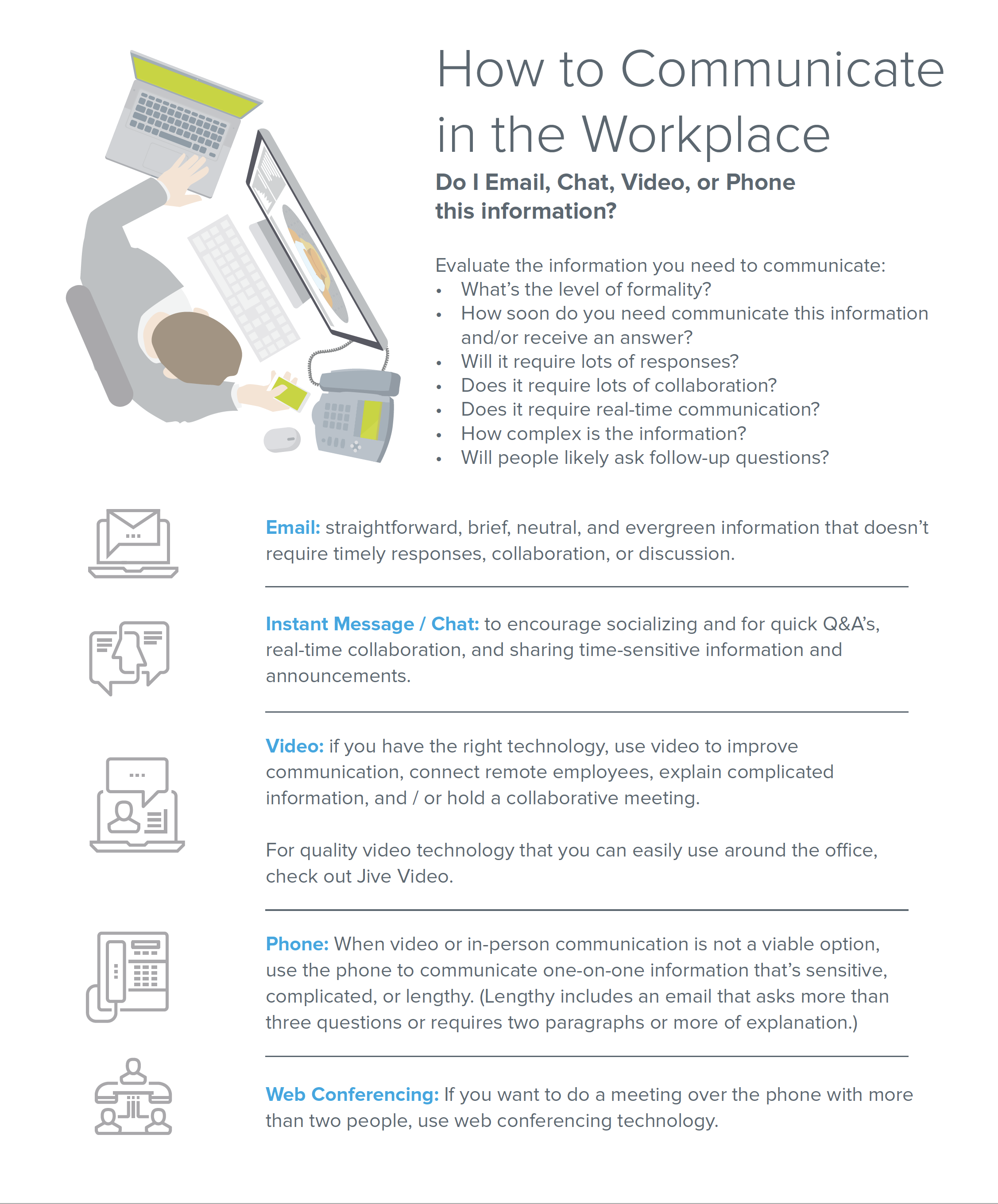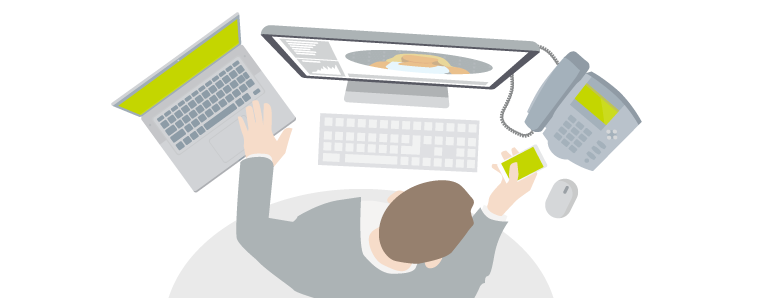Today’s Workplace Communication Conundrum
There are so many ways to communicate at work that it’s overwhelming. Every day, I find myself asking the same question: should I email, instant message, phone, video, or text this information? It’s a mundane question, but it’s important. Because if you don’t choose the right mode of communication, you’ll be ignored, misunderstood, put on the back burner, or dismissed with a vague, insufficient response.
To make your day more effective at work—and for my own sanity—I’ve brainstormed the pros and cons of workplace communication methods. From this article and infographic, you can determine a quick and easy answer to the question: should I email, chat, video, or phone this information?
Pros:
- It’s oh-so convenient: If it’s not timely information, email is ridiculously convenient. You don’t have the headache of syncing everyone’s schedules to conduct real-time communication. You can communicate general information to a whole host of people on your own schedule: during lunch, during a hair appointment, right before you go to bed, etc.
Cons:
- It’s minimalist communication: Email is less effective in establishing a human connection; it’s formal, faceless, voiceless, and often tone deaf. So it’s best to not use email when you have sensitive information that may rile up emotional reactions. Also, without this human connection, it also raises the probability of miscommunication. Without someone’s tone of voice, it’s easy to mistake sarcasm for earnestness.
- It’s a time suck: Email is time consuming! When you write an email—a document of permanence and formality that your employees can read and scrutinize—it often requires drafts and edits. At the end of that writing process, wouldn’t it be quicker to just talk on the phone? And then there’s the lag time in between emails and responses. This lag time suffocates effective and meaningful collaboration, discussions, and socializing within your team.
What is it good for? Use email to communicate straightforward, brief, neutral, and evergreen information that doesn’t require timely responses, collaboration, or discussion.
Chat / Instant Messaging
Pros
- It’s informal: This can be a pro or con, depending on your need; however, it’s a breath of fresh air to have a more off-the-cuff means of communication in the office. Emails are stiff, but chat allows for relaxed collaboration and discussion. And because it’s a more familiar way to communicate, you can build closer relationships with colleagues as you include memes, gifs, and emoticons.
- It’s speedy: Three cheers for real-time communication! Speed is perhaps the best thing about instant messaging. It can be faster to chat someone instead of getting up to talk to that coworker in his/her office. And if you chat with someone in your office, it’s not as disruptive to the recipient or their neighbors.
Cons
- It can get messy: If your topic is too complicated or includes too many people, messaging can become messy and burdensome. Think about a traditional in-person meeting. When you have a meeting, you discuss a lot of things and you write down a few notes. Your notes leave out about 90% of the meeting: bad brainstorming ideas, jokes, anecdotes, etc. Nothing is more tiresome than trying to untangle and search through informal, rough instant messaging conversations.
What is it good for? Use chat to encourage socializing and for quick Q&A’s, real-time collaboration, time-sensitive information, and announcements.
Video
If you have the option to talk to someone in person, don’t use video. Talk to them in person. Only use video when it’s physically impossible to meet up with a coworker.
Pros
- It’s emotive: All of the other communication methods we’ve discussed are blind. As nonverbal, visual cues are an important part of communication, video is the next best thing to in-person communication. The real-time communication of video makes the sharing of information quick and especially reliable. So for more complex topics, decrease the probability of miscommunication and make the process quicker with video.
- It’s engaging: Unlike phone or web conferencing, you can’t multitask (i.e., play a videogame or take a nap) during a video conference. So there’s a built in accountability that makes everyone more engaged and focused. Not to mention that video is just naturally more engaging. Add a little visual stimulus and we pay more attention, get more invested emotionally, and we are more willing to share and collaborate. In this way, video also helps build relationships between coworkers because it becomes more personal and sociable.
Cons
- It’s technical: To have an effective video communication, you need the appropriate video technology. (Sufficient video technology today should be similar to the features and qualities of Jive Video). Speaking from my own experience, bad video communication—sound delay, sound or picture cutting in and out, etc.—can make for the most infuriating and ineffective communication ever.
- It requires prep: As discussed in “Get Ready for Your Close up With These 10 Video Conferencing Tips,” there are some preparations you need to do before a video conference: test your tech in advance, pick a distraction-free background, dress professionally, and prepare any documents that you’ll be sharing.
What is it good for? If you have the technology, use video to improve communication and remote employee engagement, explain complicated information, and hold collaborative meetings.
Phone
Pros
- It’s informal: Phones are a happy medium in formality. A phone call is perhaps more intrusive and formal than a chat app, but it requires less preparation and formality than a video conference. Just the fact that we’re speaking instead of writing makes it less formal because we use more casual and informal syntax in our speech.
- It’s quick & effective: “Let’s talk this through” encapsulates the power of phone communication. Talking things through is how we fix miscommunication, so it’s one of the clearest communication methods we have. Talking is quick—much quicker than writing. When I need an answer that’s time sensitive and more complex or delicate, I call a coworker. And while it’s still blind communication, the tone of someone’s voice adds another level of engagement and cues. On a phone, you’re better equipped to pick up on tonal shifts that may cause some tense miscommunication between colleagues and coworkers (e.g., sarcasm). Plus it’s so easy to figure out there’s a misunderstanding and swiftly fix it.
Cons
- It has generational issues: Young people are less inclined to make a telephone call or answer a call. We’d rather text. Yet as a millennial, I’m slowly realizing that while I want to use text or email instead of a phone call, it often puts me at a huge disadvantage in the workplace. So there may be a bit of a learning curve for some of your office colleagues, and you may have to give them time to acclimate to the professional world where we make and take phone calls.
If you want to do a meeting with more than two people on the phone, we recommend web conferencing. Take a look at this article, “What is Web Conferencing? 10 Reasons You’ll Want It” to see the benefits of utilizing web conferencing.
What is it good for? When video or in-person communication is not a viable option, use the phone to communicate one-on-one information that’s sensitive, complicated, or lengthy. Lengthy includes an email that asks more than three questions or requires two paragraphs or more of explanation.
Communication Literacy Today
While the accumulating list of communication modes grows overwhelming, workplace communication has the opportunity to become even more effective. Now you can match the information with the right communication medium. For example, you can match the formality and complexity of information with the appropriate channel.
Yet, with all of this exciting possibility, we’re also at risk for crippling office communication if we pick the wrong mode of communication. So it’s important to be literate in channel communication. If you’re like me and still trying to figure it out, download this infographic that we’ve put together. I’m printing it and setting it right next to my computer to help me answer the question I ask myself several time a day at work: should I email, chat, video, or phone this information?


